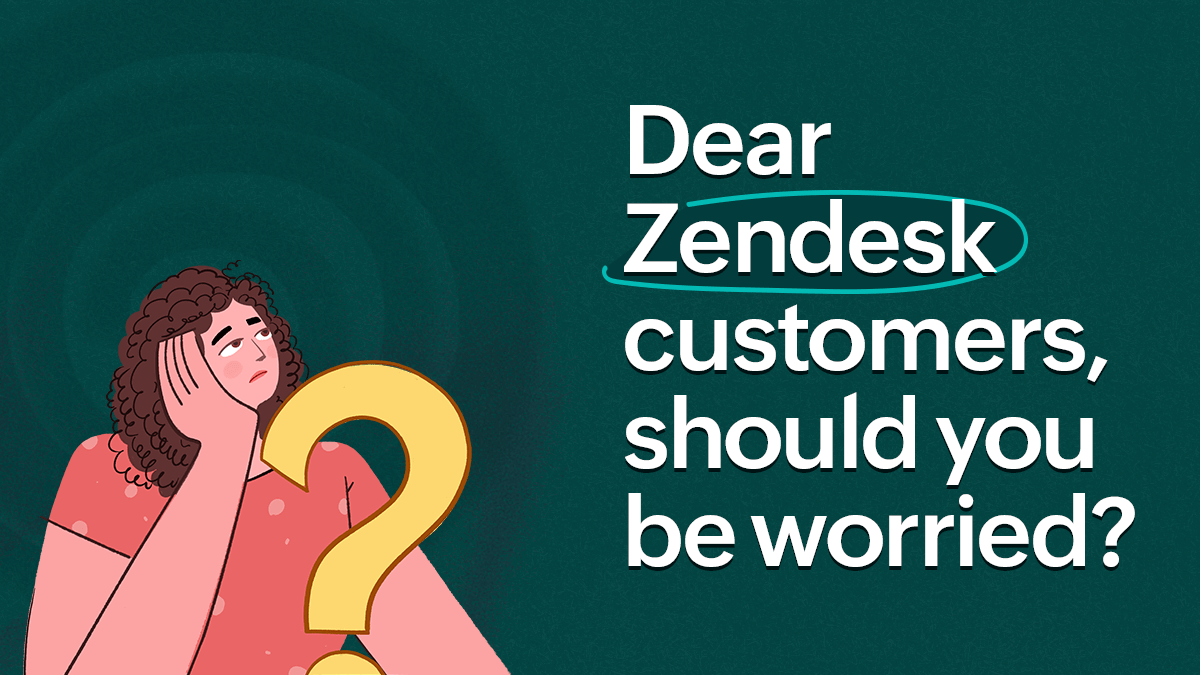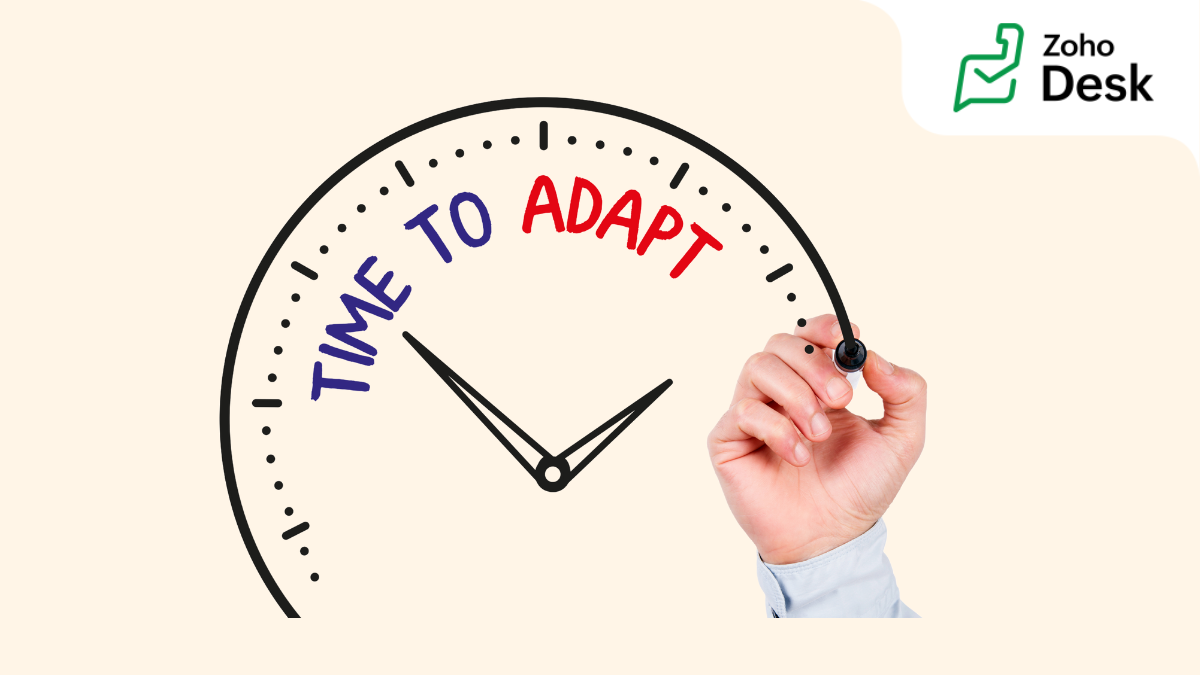- HOME
- Customer Experience
- Dear Zendesk customers, should you be worried?
Dear Zendesk customers, should you be worried?
- Last Updated : August 9, 2023
- 931 Views
- 9 Min Read

We understand that nothing touches a customer's life as much as customer service. Your agents put in efforts to turn every interaction into a memorable experience. And the support software you choose plays a crucial role in their success. This makes it necessary to evaluate your software vendor for both stability and longevity. If you are here to stay for the long haul, shouldn't you expect the same from your vendor?
Zendesk has long been an obvious choice for many businesses. It started its journey by bringing an idea discussed over coffee to life. Mikkel Svane, Alexander Aghassipour, and Morten Primdahl, the founders of Zendesk, noticed a change needed to be made to the help desk solutions of the time. And so they fixed the loopholes and introduced a simplified software solution in 2007. This caught the attention of customers and investors, paving the path for success. Zendesk was growing and so were the interests of the founders—so they decided to go public in 2014.
After going public, Zendesk's responsibilities were not limited to catering to customers' demands or developing products but also meeting Wall Street's expectations, investors' interests, and more. And that meant their responsibility towards investors might have exceeded their commitment to their customers. Why do we say that? Let's talk about what's transpired over the last few months.
Many were surprised to hear about the acquisition of a company that once rejected offers because, "they feared joining a large enterprise giant and being unhappy or, worse, that their product — which they had spent so much time working on — would be shelved."
What made a company that was adamant about staying independent change its decision? And how would this affect its customers? We decided to dig a little deeper to understand the possible changes that could result from a change in ownership.
In order to understand how Zendesk's operations are likely to change, let's first talk a little about private equity (PE) firms.
PE firms are investment management firms that provide financial aid to companies through various investment strategies, either in the form of leveraged buyouts, venture capital, or growth capital.
These firms raise private equity funds through pension funds, university endowments, high net-worth individuals, family offices, and other sources. These sources are referred to as limited partners, and they hold 99% of shares in the funds raised. Meanwhile, the general partners, responsible for making investment decisions and managing the operations of the acquired company, hold 1%. In return for their investment in the company, PE firms charge an annual management fee of 2% on managed assets and 20% on returns acquired after selling the company.
Though they raise funds from limited partners, in the case of leveraged buyouts, PE firms borrow money from different sources to fund an acquisition. The assets of the acquired company, and some assets of the PE firm, are used as collateral to obtain debt. This further increases the risk borne by the acquired company. In the case of Zendesk, Blackstone, an investment management company, has provided a $5 billion debt to fund this leveraged buy-out.
The acquired company is loaded with debt after this type of acquisition, and must service their debt through profitable returns and cash flow. Considering the number of players involved in the investment, amount of debt borrowed, and funds raised, will Zendesk be able to meet these expectations, especially considering its history?
As evident from the graph, Zendesk has failed to produce any profits over the last 10 years. But if you think they can pull a rabbit out of the hat, keep in mind that "rabbits" are usually born from years of R&D. But Zendesk has invested twice the amount in sales and marketing as they have in research and development.
Moreover, it's present state since the announcement of the acquisition speaks a different story.Source: Zendesk Investor presentations
We are aware that PE firms usually adopt rigorous strategies to ensure cash flow to meet their management fees, re-pay debt, and provide profitable returns to their investors. With a decline in Annual revenue rate so far, will PE firms operate any differently for Zendesk?
Source: Zendesk Investor presentations
Let's take a look at the strategies commonly adopted by PE firms in tough situations.
1. Employee layoffs
When a cost reduction strategy is adopted, employees are impacted significantly. As the workforce decreases, the responsibilities of retained employees increase, along with their mistrust and frustration. This tends to hamper their performance. Happy employees create happy customers, and layoffs simply don't breed positive working environments.
We saw the effects of cost reduction on the employees of Toys R Us. When the business was acquired by PE firms, management laid off 30,000 employees. A shortage of employees and under-investment in stores affected their operations and customer satisfaction levels. Ultimately Toys R Us filed for bankruptcy.
When employees are lost or shuffled around, the quality of the customer experience declines. How would you feel if your account manager was replaced by another? Would the new manager understand your business as well as the previous one? Even if they did, would you get their undivided attention and consistent service in the midst of a lay off situation?
As a customer, it's you, or your business, that faces the repercussions of investors' decisions as employee layoffs affect all the spheres of business and not just employees.
2.Shift in decision making power
When debt repayment and earning fees become of paramount importance, innovation becomes insignificant. This further changes the priorities of a business. Nick Egelanian, SiteWorks president, shares the following views on PE firms:
“At the core of these things, they’re running an investment firm, not a retail business. The retailer becomes the collateral rather than the actual business you’re in.”
Nick Egelanian, President at SiteWorks
This is usually the case for businesses PE firms acquire. Here's an example that shows what happened when an engineering company was led by an investor with no engineering background.
Boeing, an aircraft manufacturing company, was known for its craft in airplane making. The company's leaders developed an environment where everybody was treated like family. They fostered innovation, and employees poured their hearts into product development. As a result, the planes were trusted by customers, and Boeing was able to position itself as a leader of aircraft manufacturers successfully.
With privatization came many challenges, but Boeing stood its ground. It was still one of the greatest competitors in their airplane manufacturing industry. In order to expand its operations, Boeing decided to merge with McDonnell Douglas Corp. But as McDonnel Douglas Corp. employees held major senior positions and major stakes in the company, they brought a change to the atmosphere and management at Boeing. Boeing was no longer led by a team of engineers, but by an investor who adopted cost reduction strategies. Without any aviation background, James McNerney held the reins of the company. He decided to upgrade the 737 to accommodate more passengers.
The result—the 737 max—was unreliable. Negligence, and the cost reduction strategy employed by James McNerney, resulted in the production of a faulty plane that cost 346 lives. This stained the reputation of a company that was once lauded for aircraft manufacturing.
Innovation comes at a cost—but the repercussions of cost reduction are greater than the innovation costs.
Zendesk faced a similar situation when the shareholders that held only a 2% stake in the company rejected the founders' proposal of buying Momentive, the parent company of Survey Monkey. When an investor with such meager amounts of investment could affect some major product development decisions, what will happen when investors like PE firms take over Zendesk?
3.Focus on inorganic growth: The buy-build strategy
When organic innovation is out of their strategy to boost returns the PE firms rely on inorganic growth. They usually adopt a buy-build strategy, whereby they acquire smaller companies to gain fast returns in a short time. Although this boosts revenue of PE firms, it barely adds any value to the portfolio company.
According to leading financial services consulting firm, Bain and Company, "private equity funds have not only developed an outsize reliance on multiple expansion to generate returns, but they have also lost ground when it comes to adding organic value."
Acquisitions create numerous challenges that affect integration, security, company culture, management decisions, and most importantly, customer experience. Here are a few examples of acquisitions that left customers dissatisfied and the reasons behind them:
The acquisition of Nextel by Sprint Communications was intended to increase the customer base of both companies and improve cross-sell efforts. The acquisition faced a number of issues, from integration difficulties to cultural clashes. Nextel had to depend on Sprint's approval to take certain actions, which was another reason the acquisition failed. In the midst of this, the company also "struggled to keep its customers happy."
Another example of an acquisition that resulted in customer dissatisfaction was E-bay's purchase of Skype. When E-bay acquired Skype, E-bay's management intended to introduce video communication to its customers—but its customers really just needed an email feature to organize their transactions. E-bay's failure to properly integrate Skype into its operation, and its miscalculation of customers' needs, caused the failure of this acquisition.
A threat to PE firms and your operations: Changing market conditions
Another point of concern is the stability of a company. No matter how strong PE firms have been in the past, market conditions play a crucial role in deciding their future—and the future of the portfolio company. TXU, the subject of the most expensive acquisition from 2005-2007, filed for bankruptcy shortly after its acquisition due to a change in market conditions.
PE firms, which were once accustomed to cheap flow of capital, are currently facing a threat to their profitability amid poor market conditions, rising inflation, demographic trends, and a retreat from globalization. According to The Economist, PE firms might be "heading for a fall."
Considering today's high inflation, a predicted recession, and slow economic growth, will PE firms generate the same amount of revenue that they did during times of cheap debt? How will PE firms manage to provide effective returns to their limited partners (LP) who've gotten used to enjoying profits?
When the pressure of staying afloat increases, businesses are likely to increase their prices.
Recent trends indicate that some businesses increased prices multiple times in a relatively short period due to the present market conditions. But will they stop there?
Here are two likely outcomes for PE portfolio companies after purchase:
1. They are either sold or listed as an IPO by the PE firm (Buy-sell strategy)
When PE firms feel they've gained enough from the company, they head towards their strategy of selling or listing the company as an IPO. The holding power of a private equity firm is 6-7 years. But lately, the holding period has decreased from 5.8 years in 2014 to 4.4 years in 2021. With rising market concerns, will the holding power decrease further, leaving portfolio companies vulnerable to changes?
2. They end up filing for bankruptcy
When portfolio companies fail to service their debt, they file for bankruptcy. In the past, most portfolio companies, such as TXU and Toys R Us, filed for bankruptcy when debts were pushing down their operations. A leveraged buyout of Toys R Us affected the staff and the product growth. But as the portfolio companies filed for bankruptcy, the PE firms continued to stay strong.
This greatly impacts the reputations of portfolio companies, and the trust customers place in them. That's what happened with Toys R Us. Although they were saved by another company after they filed for bankruptcy, the customer experience felt by customers was no longer the same. A continuous change in operations affects the originality of a company. Will repairing a piece of broken glass ever bring it back to its original form?
Will Zendesk end up in a similar situation? Only the future will tell.
As a business, it is up to you to decide—can you depend on a vendor with an uncertain future, especially for an area as crucial as customer service? If you feel you deserve better, think about Zoho. We've been private, profitable, and reliable for 26 years.









